It’s still inspiring to look back at my diary for 2003. So many great things were happening that year. My first book, The Big Splat, or How Our Moon Came to Be, was published in April, and like any first-time author I was alternating between the heights of jubilation and the depths of despair:
“Nobody’s going to like my book.”
“Look, my book got four five-star reviews on Amazon!”
“I have no publicity tour. I have only four book readings, and I had to schedule them all myself.”
“I had a book reading in my hometown, and all my friends came, and I sold 33 books!”
“Oh, crap. No matter what I try to do to promote the book, it sells fewer copies every month than the month before.”
“At this rate, I might earn out my advance in two years. XXXXX four years. XXXXX ten years. XXXXX never.”

Here’s a picture of the local bookstore, the Capitola Book Cafe (which is, sadly, now gone), with the marquee saying, “Wed May 21 Dana Mackenzie Origins of the Moon.” It was the first time I had ever seen my name in such big letters. The night of the reading was surely one of the happiest nights of my life. I made one amusing gaffe, though. You have to know that the other bookstore in town, which was bigger, was Bookshop Santa Cruz. (It still exists.) So when the events manager at the Capitola Book Cafe introduced me, I started out: “I want to thank Bookshop Santa Cruz…” (audible gasp from the audience). After smacking my forehead with my palm, I continued, “… for turning me down so that I could speak at the Capitola Book Cafe!” That broke the tension pretty well, and the rest of my talk was just great. The events manager confided to me afterwards that I wasn’t the first person to make that mistake.
Chess-wise, the highlight of 2003 was probably the U.S. Open, which was held in southern California that year. In distant bygone days, when dinosaurs roamed the earth and chess players slew Dragons with their bare hands, the U.S. Open used to be a twelve-round tournament. In more recent times it has gone to a nine-round format. But apparently the organizer of the 2003 tournament still missed the bygone days and decided to go back to a twelve-round format, for perhaps the last time. So I had to spend a full two weeks away from home, and I decided to stretch it into three weeks so that I could do other fun things. I went to a baseball game at Dodger Stadium. I went to a tryout for Jeopardy!, the game show. (I didn’t qualify.) After the tournament was over, I went to a cryptology conference at UC Santa Barbara, where I heard about cryptocurrencies for the first time. Damn, if I’d paid attention I could be a multi-millionaire.
As for the chess tournament, I got off to an excellent start, winning my first two games and facing soon-to-be-grandmaster Varuzhan Akobian in round three. As you’ll see below, I drew an exciting game with him. His rating at the time was 2611 USCF, and in fact he is still the highest-rated player I’ve ever drawn. (A few years later I got a draw against Sergei Kudrin, who was rated 2608 at the time, and I will probably show you that game, too.)
Unfortunately, that game was the peak of my U.S. Open experience. A word to the wise: If you’re playing a 12-round tournament, you don’t want to peak in round three. In round four I lost to grandmaster Edhi Handoko of Indonesia, which was nothing to be ashamed of. But after that I languished in Class A Purgatory, playing eight games in a row against Class-A players. Most of these games were hard fights, and I scored only 5-3 in them, which is why I could never escape Class A Purgatory and get back to the Master Paradise. So in the end I had a 7.5-4.5 score and lost five rating points.
At least I did have the one highlight-reel game against Akobian, and that’s the game I will show you now. I feel as if I channeled Alexei Shirov in this game — it was “fire on board” from beginning to end. How do you draw against a grandmaster? By putting relentless pressure on them.
Varuzhan Akobian — Dana Mackenzie
1. d4 Nf6 2. c4 d5
I had started experimenting with this variation, called the Marshall Variation, a couple years earlier and had good results. There is very little theory on it, because it’s supposed to be just bad. But it’s not! There is no variation where White can get a large advantage by force. More importantly, I’m a player who likes open lines for my pieces. I’m very uncomfortable with the cramped positions of the Queen’s Gambit Declined. I’m not a fan of the locked pawn formations of the King’s Indian. The Marshall Variation is a good way to get open lines, because if White wants to refute it (as people always do), he’ll have to exchange pawns in the center.
3. cd Nxd5 4. e4 Nf6 5. Nc3 e5!
A very important point. If 6. de Qxd1+ 7. Kxd1 Ng4 Black gets his pawn back, with a fine position. The possibility of this insolent pawn thrust is one of the things I like about the Marshall Variation.
6. d5 Bc5
As desired, both of my bishops have open diagonals. Who wouldn’t prefer this to the torture of playing Black in the Queen’s Gambit Declined?
7. Be2 c6 8. Nf3 cd 9. ed Nbd7
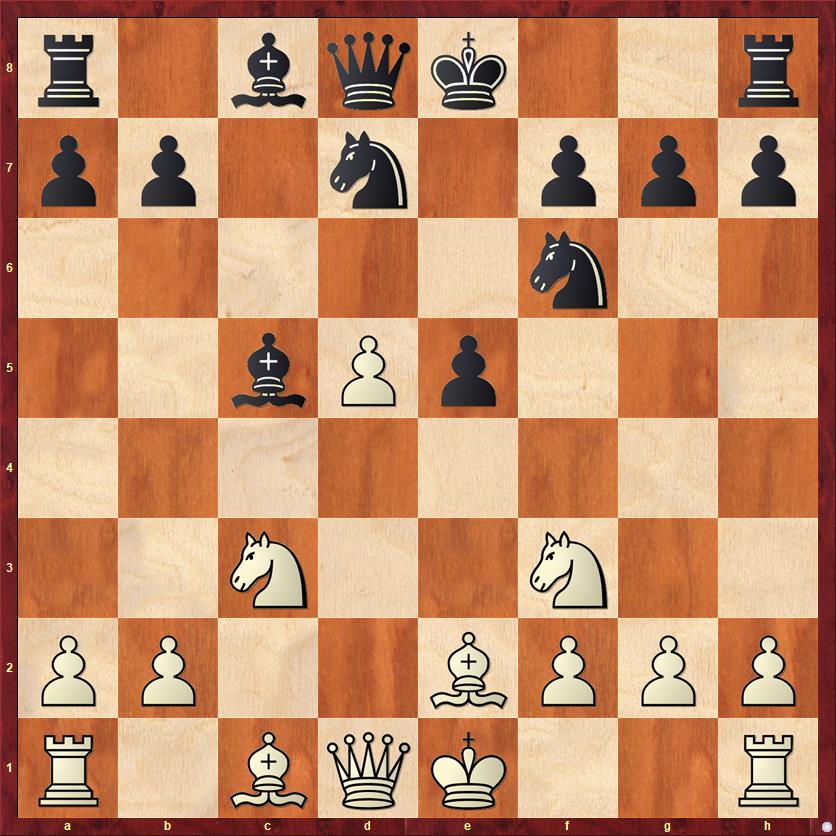
FEN: r1bqk2r/pp1n1ppp/5n2/2bPp3/8/2N2N2/PP2BPPP/R1BQK2R w KQkq – 0 10
Oddly, this is the last knight move I made in the whole game. My knights stayed rooted on those squares, d7 and f6, until a draw was agreed on move 39. As we’ll see, there were a couple occasions when I perhaps should have moved one of them.
10. O-O O-O 11. Bg6 h6 12. Bh4 g5
Fritz prefers 12. … a6, but as I wrote in my notebook, “I was not about to let White get his knight to e4.” That’s why I played 12. … g5.
13. Bg3 Re8
The natural move, but here is one of the points where I could have tried to improve the position of my knights with 13. … Nh5!?, the computer’s recommendation. This looks borderline insane, as Black (a) puts his knight on the rim, (b) leaves it undefended, and (c) leaves the e-pawn under-defended. Yet it all works out tactically, because Black wins a piece after either 14. Nxe5 Nxg3 or 14. Bxe5 g4. It’s still pretty dicey, though, because Black will have a lot of weaknesses after winning the piece. Perhaps the moral is that if you’re going to play a coffeehouse move like 12. … g5, you might as well follow it up with another coffeehouse move!
14. Rc1 a6 15. d6 b5!?
I was not impressed with Akobian’s move 15. d6, because it gives me even more open lines for my bishops, and the d-pawn itself is no threat to advance as long as Black’s knights stand in the way. The position now gets extremely sharp, extremely fast, and basically stays sharp for the rest of the game. No positional maneuvering — it’s a sword fight from now on.
16. a4 …
It’s hard to criticize this move, but 16. Nd5 was also an option.
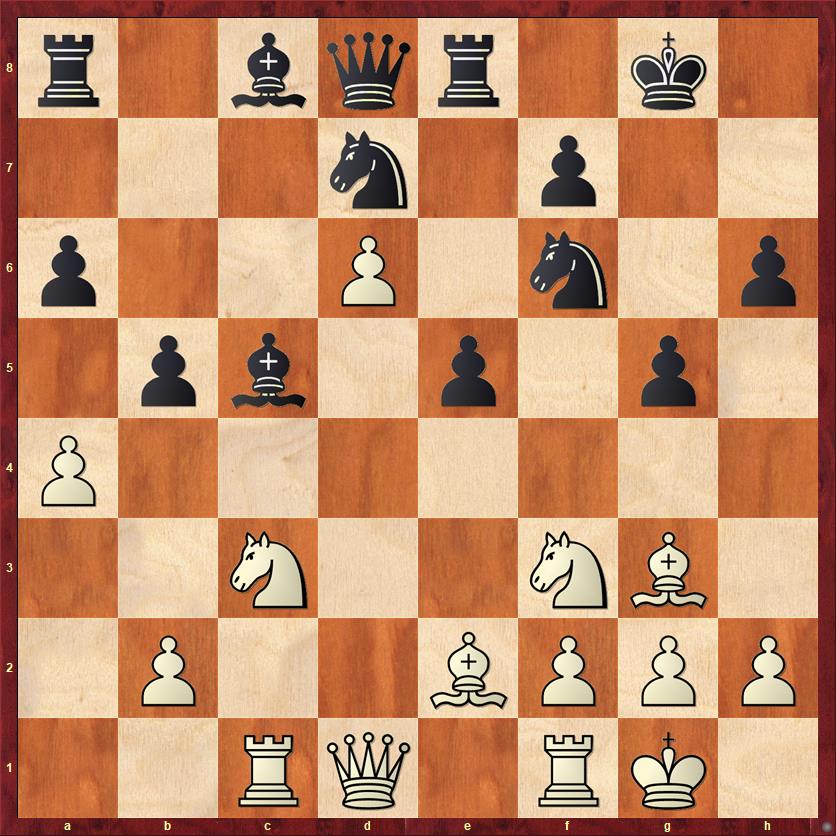
FEN: r1bqr1k1/3n1p2/p2P1n1p/1pb1p1p1/P7/2N2NB1/1P2BPPP/2RQ1RK1 b – – 0 16
16. … Qb6!
I would play this pawn sacrifice 101 times out of 100. Everything is perfect about Black’s position. He has an open diagonal for his dark-squared bishop and queen. An open diagonal for his light-squared bishop. An open file for his queen rook. Yes, White will be a pawn up, but he has two weak isolated pawns at b2 and d6. On general principles, I thought that Black must have compensation for the pawn. In fact, with my active pieces and the possibility that I might eventually win both b2 and d6, I felt that I had realistic winning chances.
In retrospect my evaluation was too optimistic, because I also have some significant weaknesses on the kingside that will come back to haunt me sooner or later. But I still think this was the right way to play the position, because there is a human on the other side of the board (even if he is almost a grandmaster), and you need to make it as hard for him as possible.
17. ab ab 18. Nxb5? …
The wrong way to capture. According to the computer, 18. Bxb5! was correct. Akobian probably didn’t want to give back the pawn so easily, but the point is that after 18. … Qxd6 19. Qxd6 Bxd6 20. Rfd1 Bf8, Black’s pieces are all getting forced into passive, defensive positions. After 18. Bxb5 Black has a multitude of other candidate moves, all of which require careful analysis — 18. … Bxd6, 18. … Ba6, 18. … Ra5, 18. … Re6. I’m not going to go over them all because I don’t want to make this an exercise in parroting computer variations. I’ll leave it to the reader to analyze them.
Still, I think that Akobian’s move is the one that most human opponents would play. He doesn’t believe that my pawn sac is sound, and so he says, “Prove it!”
18. … Ra5 19. Na3 …
Akobian blinks. Perhaps he had intended to play 19. Nc7 Rd8 20. Nxe5 Nxe5 21. Bxe5, but then noticed 21. … Bxf2+! 22. Rxf2 Rxe5. I thought this was winning for Black, but the computer discovered an unbelievable save for White: 23. Na8! Qe3 24. Rc3 Qa7 25. Rc7 with a draw by repetition. Black’s queen needs to stay on the a7-g1 diagonal but it cannot get away from the rook attacks. Still, for me, a 2100 player against a 2600, even a draw by repetition would be a great success.
19. … Bxa3 20. ba Rxa3?!
I continue to play in va banque style (contemporary English translation: “All in”) but this was one time when cooler heads perhaps should have prevailed. 20. … Ne4 wins the d6 pawn, and Black continues to have good piece activity. I think that this would just be a normal equal position, but I was trying to go for more than that.
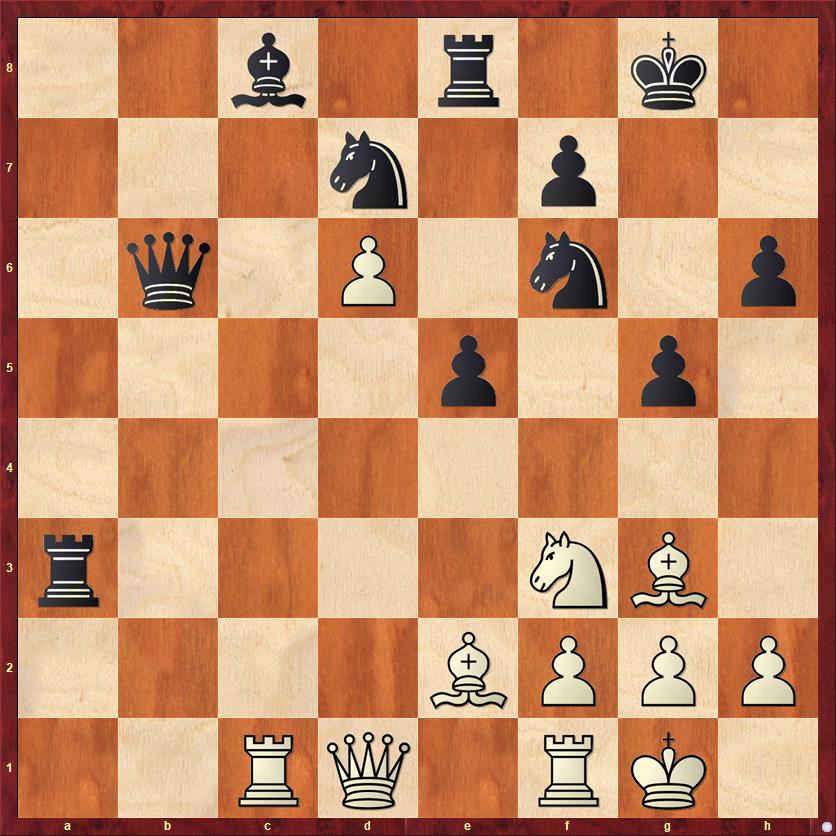
FEN: 2b1r1k1/3n1p2/1q1P1n1p/4p1p1/8/r4NB1/4BPPP/2RQ1RK1 w – – 0 21
Still playing in Shirov mode, I was trying to provoke White into taking on e5: 21. Nxe5 Rxg3! 22. Nxd7 Rxg2+ 23. Kxg2 Bxd7. I thought that with White’s kingside shattered and the pawn on d6 likely to fall sooner or later, Black would have sufficient compensation for the exchange.
After lengthy thought, Akobian decided that it wasn’t worth the risk, and he decides to join in the fun by offering a pawn sacrifice of his own!
21. Qc2?! Ba6
Again choosing piece activity over material. If 21. … Qxd6 22. Rfd1 Qe7 23. Bc4 (threatening Qg6+) Kg7 24. Qb2 I had the feeling that something bad could happen on the long a1-h8 diagonal. I decided I would rather be attacking against a grandmaster than defending. The downside of this decision is that the longer the d6 pawn is allowed to survive, the more dangerous it becomes.
22. Bxa6 Qxa6 23. Rfd1 Ra2 24. Qf5 e4
Continuing with the take-no-prisoners approach. Besides attacking White’s knight, this seals off the queen’s retreat and prepares … Ra5.
25. Nd4 Ra5 26. Qh3 h5
Now I really started to feel as if I was getting somewhere. White’s pieces are not coordinating well, and where is his bishop going to go?
27. f4?! …
Better was 27. Nc6, with the idea of playing Ne7+ first and then f4. The knight on e7 would definitely impede Black’s attack.
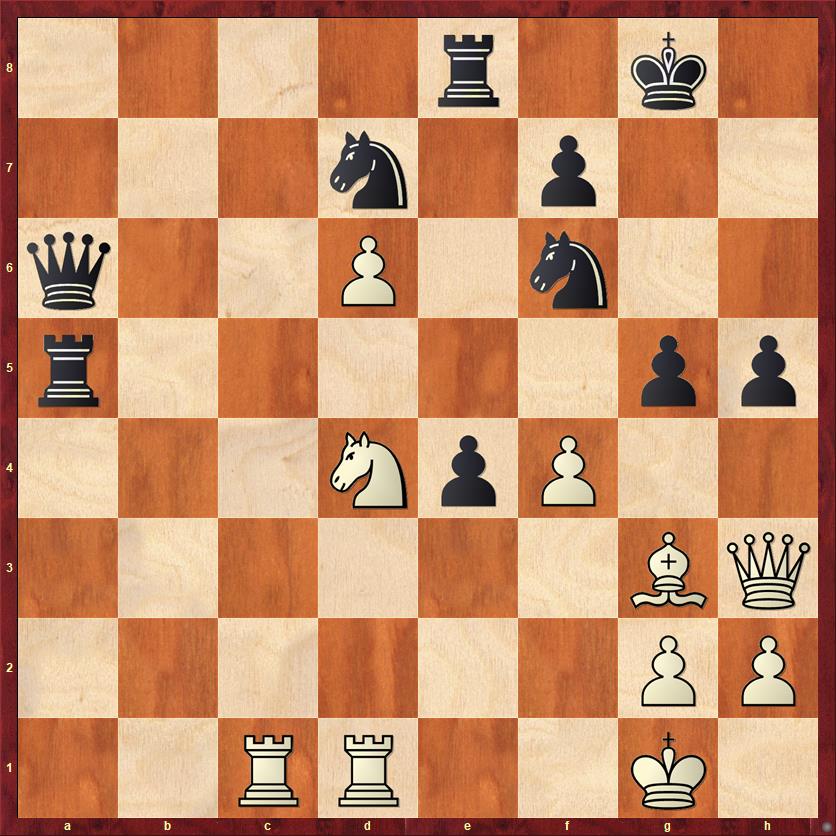
FEN: 4r1k1/3n1p2/q2P1n2/r5p1/3N3p/5PBQ/7P/2RR2K1 w – – 0 29
(Diagram 4.) Here is a major crossroads in the game, where I arguably missed a chance to get a nearly winning attack. But it’s just that — an argument. I’m not really sure if what I did was worse. I will present both sides of the case as a debate.
27. … g4?!
According to the computer, 27. … ef! en passant was the best move. Let us debate this proposition.
Argument in favor of taking en passant: This disrupts White’s pawn formation around his king, and really makes White’s kingside for the first time look even more vulnerable than Black’s. White has to recapture 28. gf. Then the move 28. … h4 seems to just win the d6 pawn.
Argument against taking en passant: The attempt to win the d6 pawn is an illusion, because White can insert the zwischenzug 29. Rc6! After, say, 29. … Qb7 30. Bf2, how does Black make progress?
Argument for taking en passant: Black in fact makes good progress by playing 30. … Rd5! By playing … h4 Black has weakened White’s defense of the d-pawn, so that Black can eventually win it. Also, Black has wicked threats like … Rxd4 and the even nastier 31. … Qxc6! 32. Rxc6 Rxd1+ 33. Kg2 Nd5, threatening mate. (See diagram.)
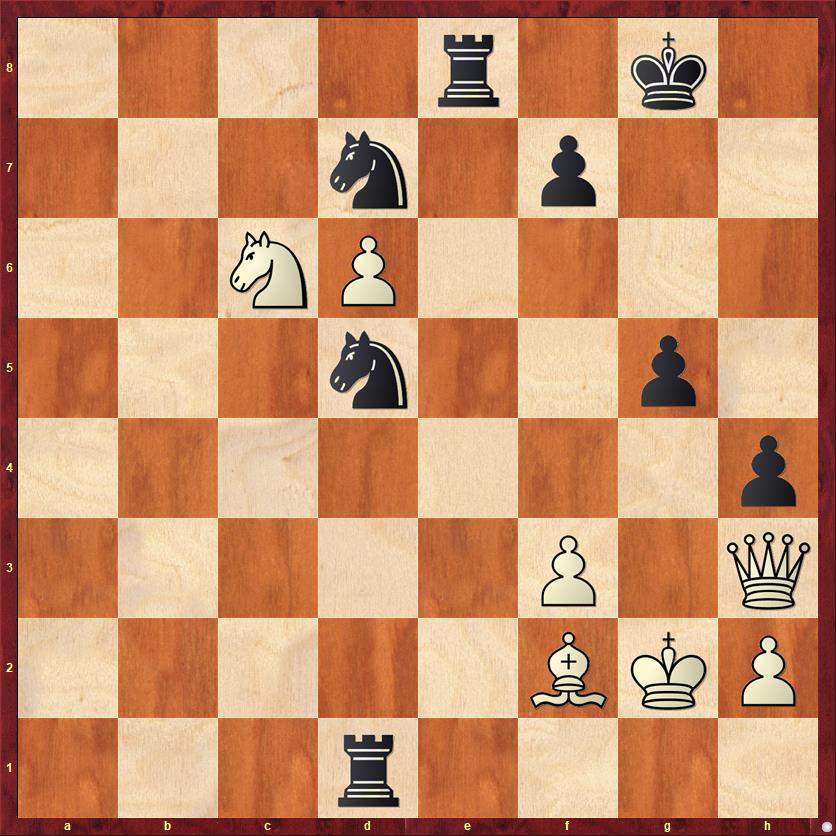
FEN: 4r1k1/3n1p2/2NP4/3n2p1/7p/5P1Q/5BKP/3r4 w – – 0 35
Argument against taking en passant: Wait a minute! Let’s not get carried away by all of this brilliance. White can strike back with 31. Rc7! Qa6 32. Rxd7, finally breaking down Black’s seemingly impregnable fortess of knights.
Argument for taking en passant: If so, Black wins with an absolutely sick fork: 32. … Qa4!! I have to insert a picture of this position, too. This whole variation is just like a symphony of remarkable tactics.
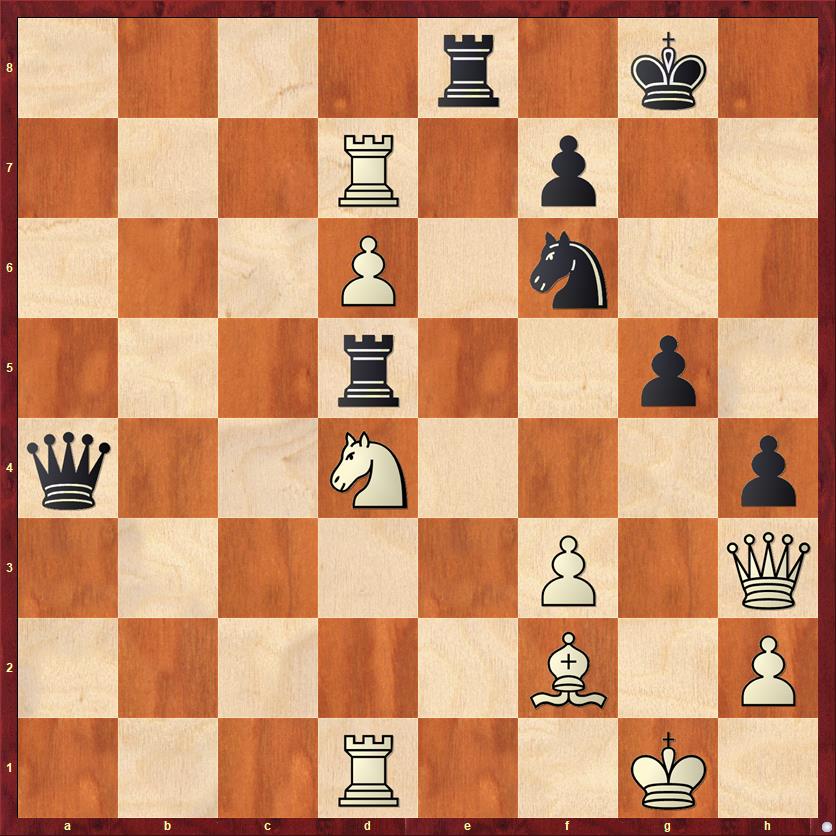
FEN: 4r1k1/3R1p2/3P1n2/3r2p1/q2N3p/5P1Q/5B1P/3R2K1 w – – 0 33
Argument against taking en passant: Okay, Einstein, I grant that in this nutso computer variation, Black emerges with the advantage through tactical means. But no human could possibly figure these variations out. I certainly didn’t figure it out over the board. Let’s go back to the previous diagram (Diagram 4). Doesn’t it make more sense to lock down the kingside with 27. … g4? I would then argue that my pieces are more active and my e-pawn is a more dangerous threat than White’s d-pawn. (Note to reader: This was in fact the argument that convinced me during the game.)
Argument for taking en passant: What makes you think that 27. … g4 will “lock down” the kingside? After an eventual f5, White will be able to infiltrate Black’s kingside on the dark squares with both the bishop and queen. (Note to reader: This is probably what I did not understand clearly enough at this point.) Also, calling Black’s knights “active” is stretching a point. They are still on defensive duty, as they have been for the whole game.
My conclusion, 18 years later: Taking en passant was better, but only if I had a computer to help me with the tactics. I think I really shouldn’t beat myself up over playing 27. … g4 instead. It was a tough decision. Black is less likely to win after 27. … g4, but also less likely to lose.
In any case, 27. … g4 was the move played, and the game continued:
28. Qh4 e3
This move, too, could be debated. I was very interested in setting up the pawn as a serious threat. But what is it threatening to do, exactly? Push on to e1, a square that White is defending four times?
29. f5 Ra2
The glimmerings of a plan emerge — Black is hoping to put the queen on the long diagonal and checkmate on g2.
30. Qg5+ Kh7 31. Bf4 Qb7 32. Nc2 …
I’m sure Akobian didn’t like playing this move. But 32. Nc6 would allow 32. … Qb2, and 32. Rc6 would allow 32. … e2 33. Re1 Qb4, another nasty fork.
32. … e2 33. Re1 …
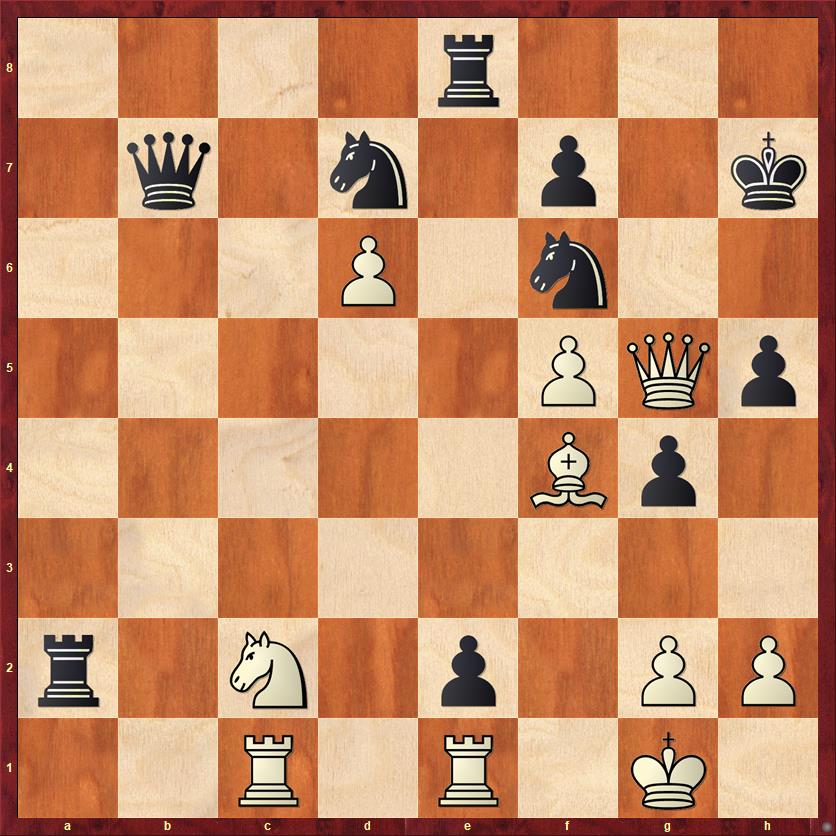
FEN: 4r3/1q1n1p1k/3P1n2/5PQp/5Bp1/8/r1N1p1PP/2R1R1K1 b – – 0 33
Someday I should write a book or at least a chapter about “Maxed-Out Attacks,” and this position would be Exhibit A. A maxed-out attack is position that optically looks wonderful, but which you have no way of improving. It looks as if I’ve gotten everything I could hope for in the attack. White’s two rooks and knight have been reduced to passivity. The e-pawn is one square away from paydirt. But … there’s no checkmate. I couldn’t find a win, and the computer can’t either. And there’s good reason: Black is only attacking with his queen. The pawn on e2 actually kind of gets in the way of the rooks. And Black’s knights, those Stationary Steeds of Strange Stickiness, are still stuck like glue on d7 and f6. Really, that’s the difference in the game. If either of the Stationary Steeds could do something useful, like jump into d3 or even f3, the game would be over. As for White, he doesn’t really have any winning chances as long as he is only attacking with his queen and bishop. So after all the incredible excitement of the previous moves, the game is heading towards a draw — both sides just have insufficient winning chances.
Except there’s one thing I have not mentioned yet: the clock. Both sides have maybe half a minute to reach the time control (move 40). Under those circumstances, anything can happen.
33. … Qb6+ 34. Ne3 Qd4 35. g3 …
Creating new weaknesses, but White needs to have the bishop defended so that he can take on h5 after 36. Qh6+ Kg8 37. Qg5+ Kh8 38. Qh6+ Nh7.
35. … Qe4 36. Qh6+ …
If White wants to play for a win, he could try 36. Rc7, but 36. … Qb4 37. Ng2 Qd4+ 38. Be3 Qe4! 39. Rxd7 Nxd7 40. Qxh5+ is only a draw. However, Black does have to avoid the tempting 38. … Qxd6?? when White wins after 39. Rxd7!
36. … Kg8 37. Qg5+ Kh7 38. Qh6+ Kg8 1/2-1/2
And that’s that, except for what the scoresheet can’t tell you. In real time, this game is being played on one of the top boards, with lots of spectators and a tournament director around, and both players’ clocks down to their last few seconds. Here is what I wrote in my diary:
“Then there was a bit of a bizarre ending. We were both in serious time pressure, with maybe 30 seconds left for the last six or seven moves. He decided to bail out by going for a perpetual check, which of course would be a draw. Thinking that we had repeated the position three times, I claimed a draw — but pressed my clock button. That made my claim invalid, so even though I looked beseechingly at the arbiter, he was not allowed to say anything. (In fact, after the game he said we had only repeated the position twice.) Meanwhile, Akobian’s time ran out. I thought that I would have to fill in the last few moves on my scoresheet (which I had omitted in the time scramble) in order to prove my repeated-position claim. Now Akobian was in a real bind — because with my scoresheet filled in, I could legally claim a win on time! So he stuck his hand across the board, and we agreed to a draw.
“What a relief! I’m okay with the fact that maybe I could have won the game on time if I hadn’t said anything, because really a draw was the fair result. I would feel a little bit unsportsmanlike to claim a win in a position where my opponent could draw by perpetual check and had every intention of doing so.”
What do you think, my esteemed readers? Should I have claimed a win on time? How would it feel to have my first victory over a grandmaster tainted in this way? Also, if I had tried to claim a win on time, Akobian might have been able to say that I had distracted him with my invalid draw claim earlier. If any TD’s are reading this, what would your ruling be in such a case?
I still think I did the right thing, and the gentlemanly thing, so as I said in my diary, I’m okay with how the game ended. I’m sure that the TD was relieved to have the game end amiably, without a dispute.
This has been another long, long post, but I hope you agree that this game was absolutely riveting from start to finish. Rather than give you a list of lessons, I’ll end with just one reflection.
Why did Black’s attack come so close but not succeed? The more I look at the game, the more I think it’s because I played only with my “pretty pieces.” This is something that grandmaster Jesse Kraai talked about in a ChessLecture long ago (though several years after this game was played). He said that most players like to move their “pretty pieces,” the ones that are already well-developed and have lots of options. In this game, my queen and queen rook and e-pawn were pretty pieces. The bishops were, too, although they just ended up being traded off. But the Stationary Steeds, and also the Stationary Rook on e8 that never budged after move 13, never found a way to participate in the attack. Jesse said that what sets masters apart is that they also know how to play with their “ugly pieces.” That is something I clearly needed to learn from this game.
Even acknowledging that shortcoming, though, I think this was a pretty darn good game.



{ 1 comment… read it below or add one }
Great game and story!
You did the right thing, IMO. Chess is about more than the final 1, 0, 1/2 result.